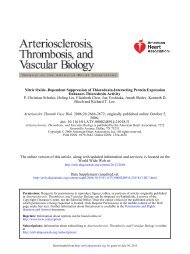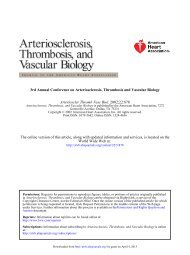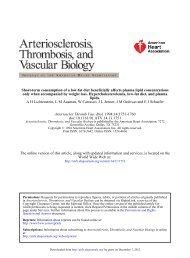CX3CR1 Deficiency Confers Protection From Intimal Hyperplasia ...
CX3CR1 Deficiency Confers Protection From Intimal Hyperplasia ...
CX3CR1 Deficiency Confers Protection From Intimal Hyperplasia ...
Create successful ePaper yourself
Turn your PDF publications into a flip-book with our unique Google optimized e-Paper software.
CX 3CR1 in the development of intimal hyperplasia. A deficiency<br />
in CX 3CR1 does not affect platelet function, but does<br />
significantly influence monocyte recruitment. CX 3CR1 deficiency<br />
also plays a role in regulating SMC activities.<br />
Materials and Methods<br />
Animal Care<br />
CX 3CR1 / (KO) mice (a gift from Dr Philip Murphy [NIH]) were<br />
backcrossed onto the C57BL/6J background for 12 generations, and<br />
age-matched CX 3CR1 / (WT) mice generated from littermates were<br />
used as controls. All mice were bred and maintained in the barrier<br />
facility at the University of North Carolina and fed Prolab RMH-<br />
3000 (PMI Nutrition International, Richmond, Ind), a normal rodent<br />
chow diet. All experimental protocols were in compliance with<br />
Institutional Animal Care and Use Committee (IACUC) guidelines<br />
and were approved by the IACUC at the University of North<br />
Carolina at Chapel Hill.<br />
Femoral Artery Injury<br />
Femoral arteries of 8- to 12-week-old male CX 3CR1 / and WT mice<br />
were injured by endoluminal passage of an angioplasty guide wire as<br />
previously described. 22 Arteries on one side were not injured and<br />
served as negative controls. Briefly, mice were anesthetized with<br />
inhaled isoflurane and femoral arteries were exposed by a longitudinal<br />
groin incision and viewed under a surgical microscope. The<br />
distal portion of the artery was encircled with an 8-0 nylon suture, a<br />
vascular clamp was placed proximally at the level of the inguinal<br />
ligament, and a 0.01-inch diameter guide wire (CrossIT-200XT;<br />
Guidant Corporation, Indianapolis, Ind) was introduced into the<br />
arterial lumen through an arteriotomy made in the distal perforating<br />
branch. After release of the clamp, the guidewire was advanced to<br />
the level of the aortic bifurcation and immediately pulled back 3<br />
times to denude the endothelium. After removal of the wire, the<br />
arteriotomy site was ligated and skin was closed. Animals were<br />
routinely monitored after surgery.<br />
Tissue Preparation, Histology, and Morphometry<br />
Mice were euthanized at days 1 (n20), 5 (n16), 14 (n8), and 28<br />
(n26) after arterial injury. Animals were perfused with phosphatebuffered<br />
saline for 5 minutes, followed by 4% paraformaldehyde for<br />
20 more minutes at 100 cm H 2O via cannulation of the left ventricle.<br />
The hind limbs were then harvested en bloc, fixed in 4% paraformaldehyde<br />
overnight, and decalcified in formic acid bone decalcifier<br />
(Immunocal; Decal Corporation, Tallman, NY) for 24 hours. Tissues<br />
containing the femoral artery were embedded in paraffin and cut into<br />
5-m sections for further analysis.<br />
Six to 10 sections per femoral artery at 100-m intervals were<br />
screened with H&E staining, and sections from the area with<br />
maximal injury response were further evaluated by staining with the<br />
Combined Masson’s elastin (CME) stain to visualize the arterial wall<br />
layers or processed for immunohistochemistry. The intima and<br />
media areas were measured by computerized morphometry (Image J,<br />
National Institutes of Health). <strong>Intimal</strong> hyperplasia was defined as the<br />
formation of a neointimal layer within the internal elastic lamina<br />
(IEL). Media area was calculated as the area encircled by the<br />
external elastic lamina (EEL) minus the area encircled by IEL. The<br />
intima-to-media (I/M) ratio was calculated as the intimal area<br />
divided by the media area. Arteries with a broken IEL or thrombosis<br />
by CME stain were excluded from the study.<br />
Immunohistochemistry<br />
For characterizing the molecular and cellular composition of arteries,<br />
immunohistochemical analysis was used to identify monocytes by<br />
mAb F4/80 (Serotec Inc, Raleigh, NC), VSMCs by alkaline phosphatase<br />
conjugated anti--actin (Sigma, St. Louis, Mo), platelets by<br />
anti-thrombocyte (Inter-Cell Technologies, Princeton, NJ), endothelial<br />
cells by anti-von Willebrand factor (vWF) (DakoCytomation Inc,<br />
Carpinteria, Calif), and CX 3CL1 by anti-fractalkine (R&D Systems,<br />
Liu et al CX 3CR1 <strong>Deficiency</strong> in Arterial Injury 2057<br />
Minneapolis, Minn). Recombinant mouse fractalkine/CX 3CL1<br />
(R&D Systems) was used to validate the specificity of CX 3CL1<br />
staining. Antigen retrieval was performed for F4/80 staining with<br />
trypsin digestion and for CX 3CL1 and vWF staining by steaming in<br />
a citrate buffer (0.01 mol/L, pH 6.0) for 40 minutes. Endogenous<br />
peroxide activity was quenched using 3% H 2O 2 in methanol for 10<br />
minutes at room temperature, and sections were blocked using 4%<br />
serum (goat, rabbit, or rat) for 10 to 60 minutes at room temperature.<br />
Primary antibodies and their respective controls were incubated<br />
overnight at 4°C. After washing, sections were incubated with a<br />
species-specific biotinylated secondary antibody (anti-mouse, antirabbit,<br />
anti-rat, and anti-goat, 1:200; Vector Laboratories, Burlingame,<br />
Calif) for 60 minutes at room temperature, followed by<br />
washes, and a subsequent 60-minute incubation at room temperature<br />
with streptavidin-horseradish peroxidase (Peroxidase Vectastain<br />
ABC Kit) to amplify antibody signal. After another wash, 3,<br />
3-diaminobenzidine (DAB) (Sigma, St. Louis, Mo) was used as a<br />
substrate for the peroxidase. Alkaline phosphatase staining by<br />
-actin antibody was visualized with the Vector Red Alkaline<br />
Phosphatase Substrate Kit (Vector Laboratories).<br />
VSMC Proliferation Analysis<br />
Four days after arterial injury, mice were injected intraperitoneally<br />
with three doses of bromodeoxyuridine (BrdU) (Roche Diagnostics,<br />
Basel, Switzerland) of 30 mg/kg at 8-hour intervals before euthanasia.<br />
Arteries were harvested on day 5 after injury, and proliferating<br />
cells were identified by immunostaining with an anti-BrdU antibody<br />
(Roche Diagnostics). For all times other than day 5 after injury, an<br />
anti-PCNA antibody (Santa Cruz Laboratories, Santa Cruz, Calif)<br />
was used to identify proliferating cells. Proliferating VSMCs were<br />
defined as -actin–positive cells that were also positive for BrdU or<br />
PCNA staining in series sections. The proliferation index was<br />
calculated as the percentage of BrdU-stained or PCNA-stained nuclei<br />
of the total number of nuclei in the indicated area. VSMC proliferation<br />
was also determined in vitro utilizing primary cultures of<br />
VSMC isolated from aortas of CX 3CR1 / and WT mice with a<br />
colorimetric assay based on the uptake of MTT by viable cells (Cell<br />
Proliferation Kit; Roche Applied Science, Indianapolis, Ind).<br />
Platelet Function<br />
Platelet function was tested in vitro with the Cone and Plate(let)<br />
Analyzer (CPA) system using a DiaMed Impact-R machine (DiaMed<br />
Israel Ltd) according to the manufacture’s instructions. Briefly, fresh<br />
samples of sodium citrated anticoagulated blood (130 L) from<br />
CX 3CR1 / and WT mice were placed in polystyrene wells and<br />
subjected to defined shear (1800/second) for 2 minutes. The samples<br />
were then thoroughly washed with phosphate-buffered saline,<br />
stained with May-Grünwald stain, and quantitated with an image<br />
analyzer. Platelet deposition on the polystyrene surface was evaluated<br />
by examining: (1) the percentage of total area covered with<br />
platelets designated as surface coverage; and (2) average size in m 2<br />
of surface-bound platelet thrombi.<br />
Monocyte Adhesion<br />
Monocyte adhesion was evaluated as previously described. 14 Briefly,<br />
spleens from CX 3CR1 / and WT mice were homogenized in<br />
RPMI-1640 with 10 mmol/L HEPES using a manual tissue homogenizer.<br />
Red blood cells were lysed with red blood cell lysis buffer<br />
(0.14 mol/L NH 4CI, 0.017 mol/L Tris-HCl pH7.5, adjust to pH7.2).<br />
Cells were washed with RPMI-1640 with 10% fetal bovine serum<br />
(FBS), passed through a 70-m nylon filter, and suspended in<br />
RPMI-1640 with 10% FBS. Adhesion of the splenocytes to fractalkine<br />
under physiological flow conditions was then tested by the<br />
parallel plate flow chamber assay with recombinant fractalkinesecreted<br />
alkaline phosphatase fusion proteins immobilized on a glass<br />
coverslip. After the run, adherent cells were stained with MOMAfluorescein<br />
isothiocyanate (FITC) antibody (Beckman Coulter, Inc,<br />
Fullerton, Calif) and the number of monocytes bound was quantified<br />
by counting MOMA cells.<br />
Downloaded from<br />
http://atvb.ahajournals.org/ by guest on March 25, 2013














